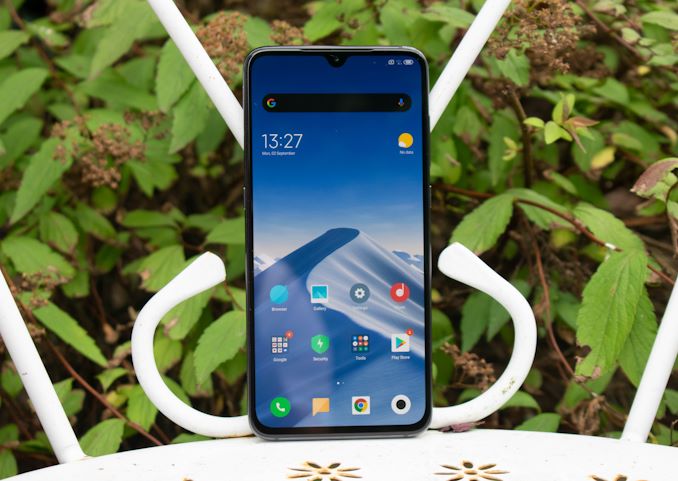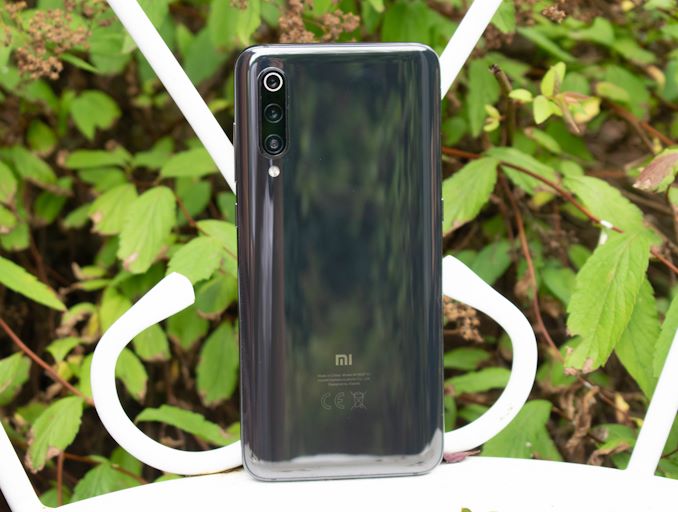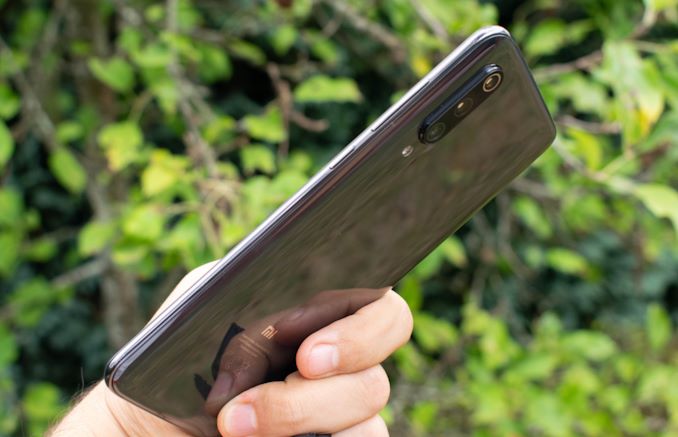The Xiaomi Mi9 Review: Flagship Performance At a Mid-Range Price
by Andrei Frumusanu on September 13, 2019 9:00 AM EST- Posted in
- Mobile
- Smartphones
- Xiaomi
- Snapdragon 855
- Xiaomi Mi9

We’re edging towards to latter half of 2019 and the next and last upcoming wave of device releases, however among the many device releases of the year one device we missed to review was the new Xiaomi Mi9. The phone was amongst the earliest releases of the year, being actually representing one of the first Snapdragon 855 devices announced back in February.
Xiaomi’s always been an interesting vendor that stood out alongside Huawei as one of the bigger Chinese vendors that have a larger presence in the west. Particularly last year and especially this year Xiaomi has made a lot of progress in terms of their push in European markets by officially releasing and offering their flagship devices in different market. The Mi9, as opposed to past iterations, thus no longer represents being a special case or import device, but rather a simple official Amazon purchase.
Today the Mi9 can be had for even less than its original 445€ launch price, being available for less than 400€, whilst still offering flagship performance, a triple camera setup, a great screen, all in a compact and attractive package. We’ll go over the device and exactly investigate how Xiaomi is able to offer such hardware at a low price, if there’s compromises and where they lie.
| Xiaomi Mi9 | ||||
| Xiaomi Mi9 | ||||
| SoC | Qualcomm Snapdragon 855 1x Kryo 485 (Cortex-A76) @ 2.84GHz 3x Kryo 485 (Cortex-A76) @ 2.42GHz 4x Kryo 485 (Cortex-A55) @ 1.80GHz Adreno 640 @ 585MHz |
|||
| DRAM | 6GB LPDDR4X | |||
| Display | 6.39" AMOLED 2340 x 1080 (19.5:9) |
|||
| Size | Height | 157.5 mm | ||
| Width | 74.67 mm | |||
| Depth | 7.61 mm | |||
| Weight | 173 grams | |||
| Battery Capacity | 3300mAh 18W charger included / 27W support |
|||
| Wireless Charging | Qi | |||
| Rear Cameras | ||||
| Main | 48MP IMX586 0.8µm pixel w/PDAF f/1.8 |
|||
| Telephoto | 12MP IMX481 1.0µm f/2.2 45° 2x zoom |
|||
| Wide | 16MP S5K3M5 1.0µm f/2.2 117° |
|||
| Extra | - | |||
| Front Camera | 20MP 0.9µm f/2.0 |
|||
| Storage | 64/128GB UFS 2.1 | |||
| I/O | USB-C no 3.5mm headphone jack |
|||
| Wireless (local) | 802.11ac Wave 2 Wi-Fi Bluetooth 5.0 LE + NFC |
|||
| IP Rating | none | |||
| Other Features | In-screen optical fingerprint sensor | |||
| Dual-SIM | 1x nanoSIM + microSD or 2x nanoSIM |
|||
| Launch / Street Price | 64GB: 449€ / ~400€ | |||
First off, hardware wise, the Mi9 is very much a flagship device in terms of its components. It’s powered by the Snapdragon 855 like many other flagships this year, representing an excellent base platform for the phone to build on.
Xiaomi bundles the SoC with 6GB of DRAM in the global models, and comes with either 64GB or 128GB of UFS 2.1 storage. Unlike many other vendors to price the higher storage tier with significant mark-up, the 128GB variant can currently be had for only 25€ more – with some listing only even being 3€ more than the 64GB variant, a great contrast to what we see from other high-end vendors out there today.
The Mi9’s display is powered by a 6.39” AMOLED screen with a resolution of 2340 x 1080. While personally I would have liked a 1440p screen, the majority of users will have absolutely no issue with the screen’s sharpness. The display is an edge-to-edge design with minimal bezels on all sides, and is characterised by having a teardrop notch at the top housing the front camera. This style of notch is common and is probably the least controversial of all implementations we’ve seen over the last 2 years.
The device’s back is a typical curved back glossy glass design with all its positives and negatives. The negatives being again that this is quite the fingerprint magnet, however Xiaomi’s ergonomics on the phone are very much fantastic and exemplary.
We find a vertical side located camera setup with triple cameras, including a regular wide-angle, zoom and ultra-wide-angle modules. The main sensor is again the common IMX586 48MP sensor that we’ve seen with essentially almost every vendor out there this year and is paired with an f/1.8 lens. The telephoto module has a 12MP IMX481 sensor with f/2.2 lens, and finally the wide-angle is an S5K3M5 16MP sensor with a f/2.2 lens with a 117° viewing angle. The noticeable feature that is lacking on all the modules here is any kind of OIS – most likely a cost-cutting measure. The lack of OIS might have also allowed Xiaomi to make the camera housing relatively more narrow and smaller than what one is accustomed to from other phones in recent years.
As mentioned, the device’s ergonomics are quite excellent and I have to say they’re among the best of device I’ve held this year. Although the phone of a larger form-factor with 6.39” screen and a device width of 74.67mm, the phone actually feels a lot smaller thanks to the very narrow and rounded frame. Even at the centre of the phone it’s only 7.61mm thick. The only compromise I see Xiaomi as having made is the relatively smaller 3300mAh battery, which competitively is a few hundred mAh below of other options in the market this year. The bonus here is that Xiaomi actually offers wireless charging on the Mi9, making it a rare feature amongst devices in this price range and definitely a bonus.
At the bottom of the phone we find the speaker grill on the right side, and symmetrical hole-cut-outs on the left side which house the bottom microphone. There’s no headphone jack here naturally – Xiaomi was amongst the first Android vendors to drop it a few years ago – still something I found unfortunate. The phone comes with a USB-C to 3.5mm adapter, which is at least more than what other vendors like OnePlus managed to offer this year. Another audio compromise on the Mi9 is that earpiece grill seems quite big and capable, it’s not being used for stereo playback, instead relying on the bottom firing speaker primarily.
On the left side of the phone we find the dual nanoSIM tray, and the assistant button below it. Xiaomi uses the Google assistant here and it works very well. The right side of the phone has your usual volume rocket button as well as power buttons. The phone also has an optical under-screen fingerprint sensor that in my experience worked quite flawlessly – it was maybe just a little slower than the implementations from OnePlus or Huawei, but it still seemed to remain faster than the ultrasonic implementation from Samsung.
Overall design wise I’m a big fan of the Mi9. It’s just such an ergonomic and no-nonsense device that I found it a rather fresh breath of air amongst other designs this year. There are some clear compromises for the phone – such as battery size, lack of IP rating or the single mono speaker, however these seem to be compromises one can live with given the price of the device.
This leads me to the question as to how Xiaomi is able to actually achieve such pricing – the company in its home market of China notably thrives on razor thing hardware margins by making profits off of their e-commerce services, but how does this play out in Europe? One way Xiaomi seems to making additional money is through ads integrated in the OS – although I love the MIUI interface and it’s an overall very clean experience, Xiaomi does show ads in instances such as when after installing application, referring to other apps such as in my experience Booking.com. This really didn’t bother me too much as it’s only ever displayed it after installing applications, but it’s something that needs mention.
















96 Comments
View All Comments
Redmyth79 - Friday, September 13, 2019 - link
What's better, the Mi 9Tpro or K20pro is not close to the Mi 9 in overall performance nor is it a flagship like the Mi 9.The Mi 9 has better display with better glass as well being Gorilla glass 6 vs 5, better DCI-P3 profile and HDR10.
IR blaster, better bands,
Better cameras 16 vs 13 and 12 vs 8
Better cooling and performance overall by far without overheating.
Better camera app.
NFC over the K20pro version yet to fully know on the Mi 9Tpro
The only thing the Mi9t or K20 variant have over the Mi 9 is the battery, everything else the Mi 9 clearly out does them in.
tdrsy - Saturday, September 14, 2019 - link
Would have liked to see how OnePlus 7 pro fares now instead of the likes of Magic, Shark or even G8. Looks like OnePlus 7 pro have quite improved now going by recent comparisons. For example comparison with Note 10+ in review of Note10+ on Gsmarena.Andrei Frumusanu - Saturday, September 14, 2019 - link
Unfortunately currently I don't have the OP7Pro.realbabilu - Saturday, September 14, 2019 - link
I suggest a photoshoot shootout contest 855 series preferably blindfold by readers since the photo results are subjective.Dragonstongue - Saturday, September 14, 2019 - link
blekk @ 3k battery size, they should be using their "standard" 4k or larger, I personally care less at this point if 4nm, 7nm super amazing god ARM cpu...I want/need battery AND 3.5mm with also good speaker quality overall ...nothing like being "forced" to plug in every day if not every couple of hours because they them phone makers to damn @#$ cheap to put good size batteries in
FLAGSHIP devices
that like getting the most $$$$$$$$$$ crazy car you can get, just to see it runs with a gas tank that barely holds 1/2 the amount if reasonably can....
WHY !!!!!!!!!!!!!
sleeperclass - Tuesday, September 17, 2019 - link
As a user of the Mi 9 for a couple of months now. It is Superb. I paid $900 NZD. I jumped on a smartphone pretty late. My first smartphone was a Motorla Atrix 2, then Apple iphone 6 and now the Xiaomi Mi 9. As is evident, I keep my phone for a long time. I have to admit that I got caught into the iOs space and would have loved to continue with Apple. Their eco system is flawless and all of it just works like a charm. It will end up locking you in and the experience is unparalleled but an XR was going to set me back no less than $1400 for a 64gb variant. Prices have dropped as I type this, to $1150 which is pretty good. Getting back to the Mi 9. It took me a while to get myself to buy this phone. The usual and endless You Tubing and Googling on the good and bad of the Mi 9. Impressions were all positive, I took the plunge and I have no regrets. Took a bit to re adjust to Android and its been a big change from my Atrix experience. The phone is snappy to do just about anything. My son hammered it with some gaming and it just flies. I had reservations on the battery and end up with 50% or sometimes more by the end of each day. Definitely not a heavy user. While a bigger battery is good to have, most users won't have a problem with the 3300mAh battery. Charging is fast too with the supplied wired charger. The Camera gets the exposure right for the most part. It does tend to add some saturation to the colors though. Videos are alright but I have seen the occasional stutter during play back while moving the camera. I guess electronic image stabilization can only do so much. Have not tried night mode. The only hardware complaint I have with this phone is the weak external mono audio via that sole bottom mount speaker. Software wise, MIUI can add some irritants via adverts as already reported in the review. It does not come in the way of day to day use. It is only when you use the Cleaner and Security App, you tend to notice advertisements floating around the screen. What I cannot forgive them for, and this has been reported by other Xiaomi users is the little app notifications icons can disappear on the top edge o the screen. It shows once and disappears. Unless you pull down the Notification Drawer, you won't notice the icons or notifications ever again. There has to be a better way to implement this.Al in all, a happy Mi 9 user experience.
NXTwoThou - Tuesday, September 17, 2019 - link
It's the rom. Xiaomi has 3 different roms. Global(10.2.9.0 PFAMIXM), China(10.2.25.0 PFACNXM), and EEA(also known as EU, but not .eu 10.2.26.0 PFAEUXM). They have beta trees, Global(9.5.23) and China(9.9.3). The China beta version is the root of everything that then gets eventually split out into all the others. It typically gets updated every week while the Global beta might be every month and the "official" every few months. I find the version numbering confusing as hell as 9.9.3 is a great deal more advanced than 10.2.25. Things get even more confusing when you look at xiaomi.eu. They basically take the china beta builds, complete the language translations, remove the ads, and do a few tweaks. They have a stable and beta. Beta currently is 9.9.6 and stable 10.2.16.0. Unfortunately they don't keep up with the stable version very much, there's such a push for the weekly beta versions. Honestly, the betas have been incredibly stable. For reference, the notification issue was fixed back in April. Why that's not fixed in the "official" roms, I have no clue except there's no telling how far behind the betas those are. I strongly suggest looking into moving to xiaomi.eu betas if they don't push you out a working "official" build next week along with the MIUI 11 stuff.Jetfire93 - Monday, March 2, 2020 - link
Hey Andrei nice and detailed reviewI just know what is mi sound enhancer and how it affects audio quality and is it different from Snapdragon audio+ equaliser